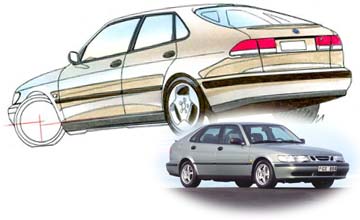BY P TIBBLES | 8th Feb 2001

Much of the update involved the running gear. The Holden Calibra-based chassis (Saab is 50 per cent General Motors owned) received big changes: the 9-3's front suspension featured more travel and retuned spring and damper rates.
The result is far more suppleness in the front end and greater ride comfort.
The 9-3 offers predictable and stable handling. The reworking of the front suspension and a stiffer body structure help by allowing the suspension to better absorb mid-corner bumps.
This is further enhanced by the steering, which also came under the microscope and received new, faster ratios and a revised mounting system to improve sharpness and general feel.
The biggest improvement came at the end of 1998 when the 113kW, 2.0-litre, low pressure turbo engine became the base engine, replacing the previous normally aspirated, 110kW, 2.3-litre engine.
Two other 2.0-litre turbo engines are available in higher level 9-3 models - the 136kW mid-range engine fitted to SE models and the new high power 147kW version in the limited-edition Monte Carlo 9-3 range.
The turbo engine is smooth and responsive once it climbs past 2000rpm and delivers a strong surge of mid-range power that proves handy for swift overtaking.
It is not, however, a low rpm powerhouse like the LPT 2.3-litre engine used in the bigger 9-5 model and must be stirred along to give its best.
That is not surprising because the maximum torque of 219Nm is developed at a highish 3600rpm - the 2.0 LPT develops its maximum torque at just 1800rpm.
Notwithstanding that characteristic, the 9-3 now rates among the fastest in its class.
Shifts through the electronic three-mode, four-speed auto are very smooth with the sport mode working well when you need extra boost. The five-speed manual works just as well with a short throw, stubby lever at your disposal.
Inside, the 9-3 aims to please the driver. Steering wheel radio controls are a nice touch and the car retains its signature centre console ignition switch.
The new heated front seats - which incorporate standard side airbags and Saab's mechanical active head restraint to reduce whiplash injuries - are comfortable and supportive.
Rear passengers have plenty of head and shoulder room but leg room is tight - partly due to the intrusiveness of the bigger front seats that are basically borrowed from the 9-5. The high seat backs also make for a claustrophobic feel.
With a wide opening rear hatch and split-fold rear seat, the 9-3 offers useable, practical luggage space.
Safety improvements include the addition of seat-mounted side airbags in addition to the twin front airbags and redesigned B-pillars that improve side-impact protection.
Though not a front-runner in the fiercely competitive executive class, the classy 9-3 creeps ahead with its turbo engine and is worth serious consideration.
- Automotive NetWorks 23/06/1999